The all-new Triumph Trident 660 hurtles into the entry-level naked market as an attractive, punchy middleweight to take on the established competition such as Yamaha’s MT-07, Kawasaki’s Z650, and Honda’s CB650R. This segment is key for manufacturers hoping to attract new riders; getting them on board and signed up to the brand as soon as possible.
The capacity of the three-cylinder engine might be 660cc, but it is not an electronically detuned Street Triple S (an A2 license compliant model available in Europe). This means a serious redesign: new crank, clutch, and gearbox with different internal ratios. Compared to the Street Triple S, first, second, third, and fourth gears are shorter; fifth and sixth taller. As you’d expect, the camshafts are redesigned to give more low and midrange torque.
Claimed peak power is 80 hp at 10,250 rpm, with peak torque 47 pound-feet at 6,250 rpm. That’s more power than the Yamaha MT-07 and Kawasaki Z650, and more torque than the Honda CB650R. Crucially, 90 percent of that torque is produced between 3,600 rpm and 9,750 rpm.
The stock exhaust system sounds brilliant for a standard bike. I’m unsure how Triumph has managed it but, despite being Euro 5 homologated and in a relatively mild state of tune, it sounds great. At low revs there is a nice burble, and then a slight change around 3,000 rpm that is more charismatic and unmistakably Triumph triple.
Power delivery is gentle and sympathetic for the first 5 to 10 percent of throttle travel, with a softness that is perfect for new and inexperienced riders (Rain mode, incidentally, softens the power delivery even further). After that initial turn, throttle response becomes more direct but is still smooth.
There is a fluid feel to the Trident. The British triple drives positively from low down and you can make quick and efficient progress without tapping back too many gears. But if you should want to have some entertainment, go down a gear or two on the smooth gearbox and the Trident will deliver—even to experienced hands.
I did hit the rev limiter on a few occasions, whilst getting a little too carried away. But, to be fair, most of my two days of test riding was at altitude, which sapped power and didn’t do the new Trident justice. This entry-level bike is far from being boring.
Quoted wet weight is 417 pounds, on par with the twin-cylinder machines in this field. The weight isn’t intimidating for small and inexperienced riders, while the seat is low (31.7 inches high) and narrows helpfully toward the fuel tank. I’m 5 feet, 7 inches tall and managed to get flat-footed on both sides of the bike. Showa suspension controls the springs at each end; there’s no adjustment on the front and only preload on the rear, but Triumph hasn’t thrown underdamped, budget suspension at the Trident; this is an impressive setup for this type of bike. For new riders, the suspension is sympathetic, easy to get along with, and takes on 90 percent of road surfaces with ease.
At speed the Showa setup works well. Ground clearance is plentiful; the Trident doesn’t drag its pegs like some of the competition, and holds a confident, smooth line. The natural riding position allows you to control and throw the bike around with relative ease, quality Michelin Road 5 tires performing reassuringly. In fact, the Trident’s handling is hard to fault. Yes, the Showa suspension lacks adjustability, but 99 percent of riders won’t feel the need to twiddle anything, and there is all-important rear spring-preload adjustment for when you are adding a pillion or luggage.
Nissin two-piston calipers, grabbing twin 310mm discs, are just about up for the job. They have a progressive feel, the lever is span adjustable, and again are ideal for new riders. ABS comes as standard, of course, but without an IMU they are not lean-sensitive.
There are two rider modes, Road and Rain, which is class-leading in this category, and easily accessible via the new switch gear and full-color TFT dash. Each mode changes the power characteristics via the fly-by-wire throttle as well as traction control and ABS. In Rain mode the rider aids are set at a higher level of intervention. It’s a shame you can’t switch on or deactivate the TC on the move.
My testbike was fitted with optional heated grips, and there are 44 additional items to choose from the official Triumph accessories catalog. From the tech side, you have My Triumph Connectivity System, which connects to the new TFT dash, allowing phone/music, navigation, and GoPro access. There are also an optional USB charger, tire monitor system, and scrolling indicators plus a list of cosmetic—the billet bellypan looks nice—luggage, and security accessories. Personally, I’d be opting for the quickshifter, which enhances every Triumph fitted with it.
Even after two days of riding the Trident was still rewarding and making me smile; it really is hard to fault when you compare to the competition and consider its low price. Triumph is onto a winner here.
There are some nice touches like the cutaway fuel tank and neat TFT dash with Bluetooth connectivity. The engine is soft low down, then delivers enough performance to have fun on the road, even for experienced hands, and it is backed up by Triumph’s lovely triple soundtrack that gives it soul and character. The handling is excellent, its low weight unintimidating, while the brakes are just about up for the job. Well-thought-out electronic rider aids give it an extra tick above the competition. But with a new Z650, CB650R, and MT-07 for 2021, this category is more competitive than ever.











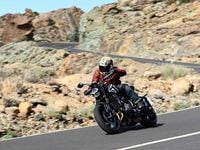




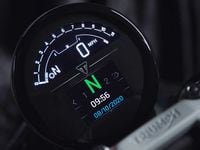



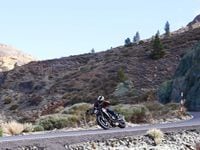
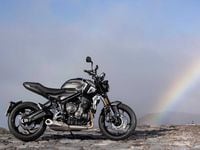

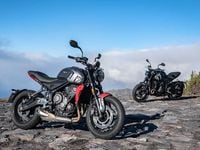
/cloudfront-us-east-1.images.arcpublishing.com/octane/QSTCM6AVEZA5JJBUXNIQ3DSOF4.jpg)
/cloudfront-us-east-1.images.arcpublishing.com/octane/U4I7G625B5DMLF2DVIJDFZVV6M.jpg)
/cloudfront-us-east-1.images.arcpublishing.com/octane/B6XD6LS6IVCQPIU6HXDJSM3FHY.jpg)
/cloudfront-us-east-1.images.arcpublishing.com/octane/ICL63FEDDRDTTMINYICCEYGMDA.jpg)
/cloudfront-us-east-1.images.arcpublishing.com/octane/FCGZHQXRBZFLBAPC5SDIQLVF4I.jpg)
/cloudfront-us-east-1.images.arcpublishing.com/octane/WNOB6LDOIFFHJKPSVIWDYUGOPM.jpg)

/cloudfront-us-east-1.images.arcpublishing.com/octane/X33NU3E525ECRHXLNUJN2FTRKI.jpg)
/cloudfront-us-east-1.images.arcpublishing.com/octane/6KKT5NNL2JAVBOXMZYS5ZO76YA.jpg)
/cloudfront-us-east-1.images.arcpublishing.com/octane/J5RKG5O455GMPGQRF2OG6LRT7A.jpg)
/cloudfront-us-east-1.images.arcpublishing.com/octane/GX2CIZKQVRH2TATDM26KFG2DAE.jpg)
/cloudfront-us-east-1.images.arcpublishing.com/octane/ZWIDYSAKQZHD5BHREMQILXJCGM.jpg)
/cloudfront-us-east-1.images.arcpublishing.com/octane/CYUHJZCTSJCH3MRAQEIKXK7SCQ.jpg)
/cloudfront-us-east-1.images.arcpublishing.com/octane/LKOFINY56FCXJCANJ5M7ZDQUBY.jpg)
/cloudfront-us-east-1.images.arcpublishing.com/octane/4NBPDACMWJH63JQYJVK3QRBDZI.jpg)
/cloudfront-us-east-1.images.arcpublishing.com/octane/KKHQHRR3FJGX7H2IPU6RALMWG4.jpg)

/cloudfront-us-east-1.images.arcpublishing.com/octane/5IOFS5JAE5FOXMNA23ZRAVVYUU.jpg)
/cloudfront-us-east-1.images.arcpublishing.com/octane/CGXQ3O2VVJF7PGTYR3QICTLDLM.jpg)

/cloudfront-us-east-1.images.arcpublishing.com/octane/OQVCJOABCFC5NBEF2KIGRCV3XA.jpg)
/cloudfront-us-east-1.images.arcpublishing.com/octane/OPVQ7R4EFNCLRDPSQT4FBZCS2A.jpg)
/cloudfront-us-east-1.images.arcpublishing.com/octane/YBPFZBTAS5FJJBKOWC57QGEFDM.jpg)
/cloudfront-us-east-1.images.arcpublishing.com/octane/W5DVCJVUQVHZTN2DNYLI2UYW5U.jpg)